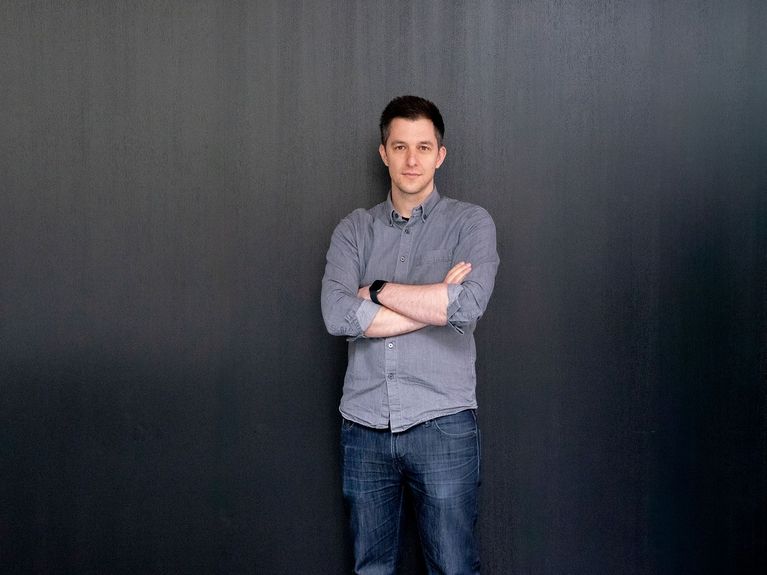Portrait
On the trail of RNA

A daring e-mail took biochemist Mathias Munschauer from Mannheim to New York, to the laboratory of one of the world’s most renowned RNA researchers. Today, he is one of the most sought-after experts in the field.
If he hadn’t written that email back then, with the chutzpah of a student, Mathias Munschauer would probably not be sitting in this office now, worrying about whether the EU funding and equipment for his new laboratory would arrive in time. The email was sent to the US and Munschauer addressed it directly to Thomas Tuschl, one of the world’s most renowned biochemists and RNA researchers. “I wrote him that I would like to work in his laboratory at Rockefeller University for six months,” says Mathias Munschauer. At the time, he was not surprised that he was accepted shortly afterwards.
The year was 2008, and RNA research was booming as new technologies made it possible to target the biochemical machinery of cells. In cells, RNA (ribonucleic acid) is responsible for translating genetic information into proteins and for transferring information between cells. It is therefore an important target when looking for new drugs to treat disease. During his six-month laboratory internship in New York, Mathias Munschauer experienced the optimism and enthusiasm of his experienced colleagues, such as his mentor Tomas Tuschl. He began to immerse himself in the subject. Now 39, he is one of the world’s leading experts in RNA research and group leader at the Helmholtz Institute for RNA-based Infection Research (HIRI) in Würzburg. He has recently been appointed to the Goethe University in Frankfurt, where he is setting up his new laboratory. He has thrown himself into his work so much that his office bookshelves are still almost empty, “there will be time for that later,” he says with a shrug.
Picture: HIRI / Luisa Macharowsky
Mathias Munschauer knew little about RNA when he graduated from high school in Alzey, Rhineland-Palatinate, Germany. He was interested in math, biology and English, and at a career information event he heard the head of research at a pharmaceutical company rave about studying biotechnology at the Mannheim University of Applied Sciences. Without further ado, he enrolled. “The course was really good,” he says, “and the compulsory internships were really great. You didn’t just go into some teaching lab, you actually went into research.” He went to the German Cancer Research Centre in Heidelberg and was impressed by the work of two slightly older PhD students, and it was then that Mathias Munschauer began to consider research as an option for himself.
It was around this time that he received a paper from Thomas Tuschl, the luminary from New York’s Rockefeller University. The paper was about RNA interference: A mechanism in the cell in which RNA molecules specifically switch off genes by interacting with the mRNA that carries the information of the gene being read. “I was immediately impressed by this paper: The procedure described was so logical, so rigorous, so systematic!” He decided to write to Thomas Tuschl, and sent the email that would shape his future career.
RNA is universal in biochemistry, whether in animals, plants or microorganisms. Mathias Munschauer’s current research focuses on RNA viruses that cause disease, with influenza and coronaviruses being two such RNA viruses. “We are particularly interested in the central molecule of these viruses, the RNA genome,” explains Munschauer: “When a human cell is infected by a virus, its RNA genome takes control of the cell, so to speak. ” His team is trying to determine the exact mechanisms involved and how the infected cell tries to defend itself. The hope is that if these mechanisms can be deciphered, it will be possible to intervene with drugs and thus stop the RNA viruses.
Munschauer is working with a whole arsenal of high-tech methods: For some questions he uses mass spectrometry, for others he relies on single-cell sequencing. What they all have in common is the huge amount of data generated by the measurements and observations. Special algorithms then look for patterns in this data, “and suddenly you discover new details about infections that you couldn’t see before.”
He acquired many of his tools in the US: After his first stay as a student, he completed his PhD in a joint program between the Max Delbrück Center and New York University, and then spent five years as a postdoc in Cambridge with Eric Lander, the leading researcher behind the decoding of the human genome. In 2019, he will return to Germany as a Helmholtz Young Investigator Group Leader at the HIRI in Würzburg.
Mathias Munschauer is still in contact with Thomas Tuschl, to whom he wrote an email full of youthful enthusiasm. And he has never regretted his intuitive decision to follow the trail of RNA. He has been to many scientific conferences, he says, but: “The RNA community meetings are my favorite. The field is so incredibly innovative: Every time there are completely unexpected findings that take us a step further.”
Readers comments